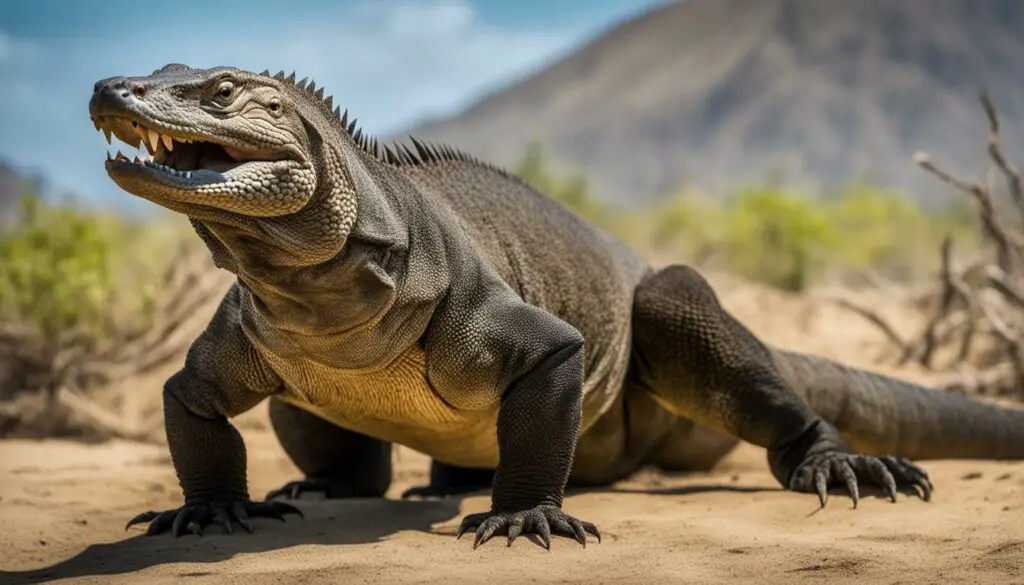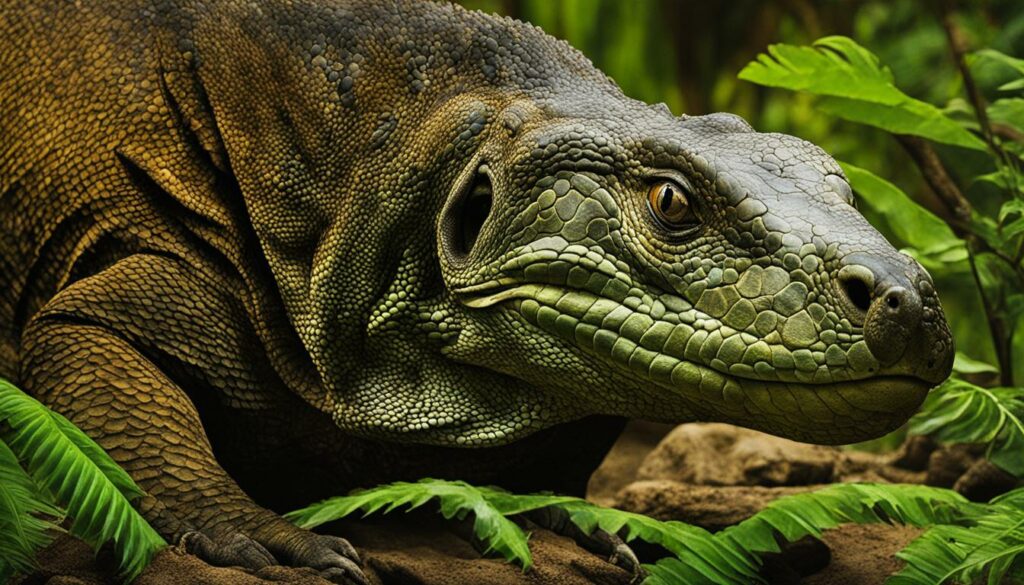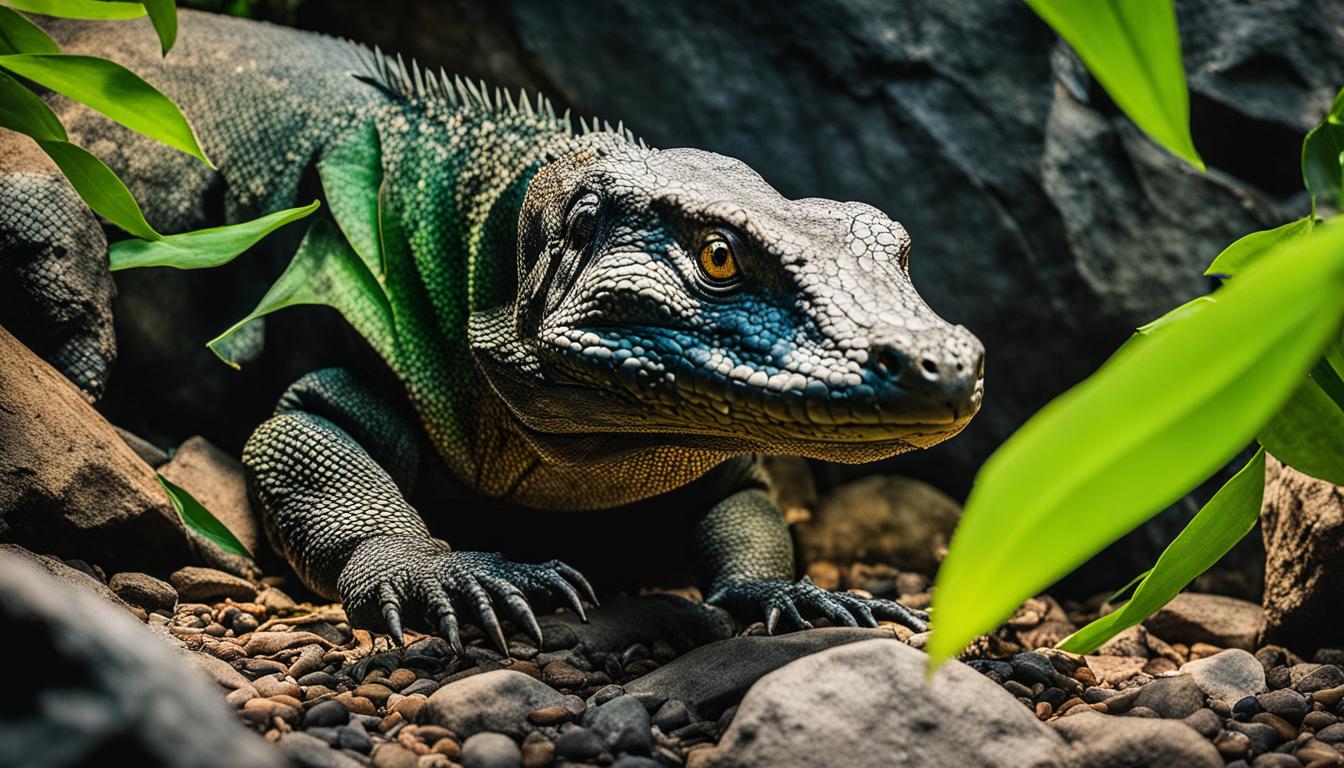Welcome to our exploration of Komodo dragon behavior, where we will delve into the captivating world of these ancient reptilian giants. Komodo dragons, native to the Indonesian islands, are known for their impressive size, unique hunting techniques, and complex social behaviors. Understanding their behavior is not only fascinating but also crucial for the conservation of these endangered species. So, whether you’re a wildlife enthusiast or involved in research and conservation efforts, join us as we uncover the intriguing aspects of Komodo dragon behavior.
From how they interact with their environment, prey, and each other, to their mesmerizing mating rituals and remarkable survival strategies, Komodo dragons have much to offer in terms of behavior and adaptation. Throughout this journey, we will provide you with valuable insights into their lives and behaviors, shedding light on their incredible world.
So, get ready to embark on an adventure filled with fascinating discoveries about the behavior of these ancient reptiles. Let’s delve into the captivating world of Komodo dragons and gain a deeper appreciation for their uniqueness and the importance of their conservation.
Komodo Dragon Diet
A fascinating aspect of Komodo dragon behavior is their diet, which consists of a variety of prey. These impressive lizards are primarily scavengers, feeding on carrion that they come across in their habitat. However, they are opportunistic hunters as well, capable of taking down live prey.
Komodo dragons feed on a range of animals, including insects, small mammals, birds, and sometimes even larger animals like deer or pigs. Their hunting techniques involve stealthy approaches and quick strikes, utilizing their sharp claws and powerful bites to overpower their prey. With their strong jaws and serrated teeth, they can deliver a lethal blow to their victims.
It’s important to note that the diet of Komodo dragons can vary depending on the availability of prey in their environment. Their ability to adapt to different food sources showcases their remarkable survival strategies. By consuming a diverse range of prey, Komodo dragons ensure that they have the necessary nutrition to thrive in their ecosystem.
Komodo Dragon Diet Breakdown
| Prey | Diet Composition |
|---|---|
| Carrion | 70% |
| Insects | 15% |
| Small Mammals | 10% |
| Birds | 4% |
| Large Animals (Deer, Pigs) | 1% |
The table above provides a breakdown of the typical diet composition of Komodo dragons. It shows the percentage of different prey types that contribute to their overall diet. This data gives us valuable insights into the feeding habits of these fascinating creatures.
Komodo Dragon Hunting
When it comes to hunting, Komodo dragons are highly skilled predators with fascinating predatory habits and hunting techniques. These impressive reptiles are ambush hunters, relying on their keen sense of smell to track their prey. They use their remarkable camouflage to get close to their victims before striking with lightning speed and precision.
Table:
| Prey | Hunting Technique |
|---|---|
| Small mammals, birds, insects | Stealthy approach and quick bite |
| Deer, pigs | Ambush and powerful bite |
| Carrion | Scavenging and consumption |
The Komodo dragon’s hunting strategy involves a combination of patience, agility, and strength. They patiently wait for the perfect moment to strike, using their powerful muscular tails as weapons to knock down or incapacitate their prey. Their serrated teeth and venomous saliva play a crucial role in subduing their victims, ensuring a successful hunt.
In summary, Komodo dragons are apex predators that employ stealthy approaches and powerful bites to secure their meals. Their hunting techniques are a testament to their remarkable adaptability and survival skills, making them one of the most formidable predators in the animal kingdom.
Komodo Dragon Defense
Komodo dragons are one of the most feared apex predators in the animal kingdom. Their formidable defense mechanisms make them a force to be reckoned with in their natural habitat. First and foremost, their deadly venom sets them apart from other predators. With a single bite, they can inject a potent venom into their prey, causing rapid paralysis and death. This venom, rich in toxins and bacteria, ensures a successful hunt by incapacitating even large prey, such as water buffalo. Komodo dragons are the only lizards known to possess venom, making them truly unique.
In addition to their venomous bite, Komodo dragons are also renowned for their territorial behavior. They fiercely defend their territory, engaging in aggressive displays that intimidate potential intruders. Any creature, including humans, that trespasses on their land may fall victim to their powerful jaws and sharp teeth. This territorial behavior is crucial for their survival, as it ensures they have access to resources and a secure environment in which to hunt and reproduce.
“Komodo dragons are one of the most feared apex predators in the animal kingdom, with their deadly venom and ferocious territorial behavior.”
To further protect themselves, Komodo dragons have developed robust physical adaptations. Their thick, scaly skin acts as a shield, providing protection from external threats. Their muscular bodies, strong limbs, and sharp claws allow them to overpower and subdue their prey. These physical attributes, combined with their aggressive nature, make them formidable predators.
When encountering a Komodo dragon in the wild, it is crucial to exercise caution and maintain a safe distance. These majestic creatures should be appreciated from afar, as their defense mechanisms and territorial behavior make them unpredictable and potentially dangerous.

Table: Comparison of Komodo Dragon Defense Mechanisms
| Defense Mechanism | Description |
|---|---|
| Venomous Bite | Komodo dragons possess venom glands in their jaws, allowing them to inject a potent venom into their prey, causing paralysis and death. |
| Territorial Behavior | Komodo dragons fiercely defend their territory, engaging in aggressive displays and attacking any intruders to protect their resources and secure their environment. |
| Physical Adaptations | Thick, scaly skin, strong jaws, sharp teeth, muscular bodies, and powerful limbs provide physical protection and enable Komodo dragons to overpower and subdue their prey. |
As you can see, Komodo dragons employ a combination of venomous bites, territorial behavior, and physical adaptations to defend themselves and dominate their environment. Understanding and respecting their defense mechanisms is essential for ensuring their survival and maintaining a healthy ecosystem.
Komodo Dragon Social Behavior
When it comes to their social behavior, Komodo dragons are quite interesting creatures. For starters, juveniles tend to live in bachelor groups until they reach around two years old, after which they will join a mixed-sex group. Although males and females do interact with each other, adult males are typically dominant over all other members of the group.
Komodo dragons use visual communication to convey a variety of messages, including warnings and threats. They can also use smell to indicate their dominance or reproductive state. Interestingly, Komodo dragons have been observed licking one another’s mouths as a sign of affection.
“Komodo dragons exhibit a complex range of social interactions, from dominance displays to cooperative hunting. These behaviors are vital for establishing hierarchies within their groups and ensuring the survival of the species,” says Dr. Sarah Thompson, a leading expert on Komodo dragons.
Understanding the social behavior of Komodo dragons is crucial for conservation efforts. By studying their communication methods and social interactions, researchers can gain valuable insights into the species’ dynamics and develop effective strategies for their protection.
Table: Komodo Dragon Social Behavior
| Behavior | Description |
|---|---|
| Bachelor Groups | Juvenile Komodo dragons live in male-only groups until they reach two years old. |
| Mixed-Sex Groups | After reaching maturity, Komodo dragons join mixed-sex groups. |
| Dominance | Adult males are typically dominant over all other members of the group. |
| Visual Communication | Komodo dragons use visual cues to convey messages, including warnings and threats. |
| Smell Communication | They use smell to indicate dominance or reproductive state. |
| Affection | Komodo dragons have been observed licking each other’s mouths as a sign of affection. |
Komodo Dragon Mating Behavior
When it comes to the mating behavior of Komodo dragons, it is truly fascinating to observe their unique rituals and interactions. These ancient reptilian giants exhibit behaviors that are both intriguing and captivating. One of the most remarkable aspects of Komodo dragon mating behavior is their tendency to exhibit monogamy. Unlike many other reptile species, Komodo dragons form long-term pair bonds with their chosen mates. This means that once a male and female Komodo dragon have paired up, they will remain together for an extended period of time.
The courtship rituals of Komodo dragons are also quite elaborate and can last for hours. Males often engage in impressive displays to attract the attention of females. These displays can include dances, head bobbing, and even chasing one another. If the female is interested, she will respond by reciprocating these behaviors, indicating her willingness to mate. Once a pair has formed, they will embark on a complex courtship ritual that involves mutual sniffing, licking, and intertwining of their bodies. These behaviors serve to strengthen the bond between the male and female and ensure successful reproduction.
The Komodo Dragon Mating Ritual
The mating ritual of Komodo dragons is a fascinating spectacle. The male will approach the female from behind and use his long tongue to flick her body, which is believed to stimulate her reproductive behavior. The male will then mount the female from behind, grasping her tightly with his forelimbs and using his powerful tail for balance. The mating process can be quite vigorous, lasting anywhere from a few minutes to several hours. Once mating is complete, the female will lay her eggs in a carefully constructed nest and provide parental care until they hatch. This unique mating behavior contributes to the survival and continuation of the Komodo dragon species.
In summary, the mating behavior of Komodo dragons is a complex and fascinating aspect of their lives. From their monogamous pair bonds to their elaborate courtship rituals, these ancient reptilian giants exhibit behaviors that are both captivating and essential for their species’ survival. By understanding and appreciating the intricacies of their mating behavior, we can gain a deeper insight into the remarkable world of Komodo dragons.
Komodo Dragon Reproduction
Reproduction is a crucial stage in the life cycle of Komodo dragons, allowing these magnificent creatures to ensure the survival of their species. As fascinating as their mating behavior, their reproductive process showcases unique adaptations and intricate parental care. Understanding the intricacies of Komodo dragon reproduction provides valuable insights into their remarkable reproductive strategies.
Female Komodo dragons lay their eggs in nests made from sticks and leaves, carefully selecting a location that provides optimal conditions for incubation. The nesting period typically occurs in September, with females laying between one and twelve eggs.
Table: Komodo Dragon Reproduction Details
| Aspect | Details |
|---|---|
| Egg Laying | September |
| Number of Eggs | 1-12 |
Once the eggs are laid, the female meticulously incubates them for a period of two to three months. During this time, she remains dedicated to protecting and nurturing her offspring, demonstrating remarkable parental care. After the incubation period, the eggs hatch, and the young Komodo dragons emerge, entering the world as vulnerable hatchlings.
The newly hatched Komodo dragons remain under the watchful eye of their mother for up to two years. During this period, they learn essential survival skills, including hunting and navigation, under her guidance. This extended period of parental care contributes significantly to the development and success of the young dragons.
Komodo Dragon Behavioral Adaptations
Komodo dragons, renowned as the world’s largest lizards, have evolved a range of fascinating behavioral adaptations that contribute to their survival in their unique habitat. These apex predators have developed a keen sense of smell, allowing them to detect carrion from several miles away. This adaptation enables them to scavenge for food efficiently and locate potential prey.
Additionally, Komodo dragons display remarkable hunting strategies. They possess strong, muscular tails, which they use as powerful weapons to strike their prey, causing injury or even death. Their serrated teeth and venomous saliva further aid in subduing and incapacitating their victims. To accommodate their large meals, Komodo dragons possess incredibly elastic stomachs that can expand to accommodate prey that can be up to 80% of their own body weight.
Furthermore, Komodo dragons have adapted to consume rotting flesh without suffering from severe infections. They possess a unique adaptation in their blood that inhibits the growth of harmful bacteria. This adaptation allows them to feed on carrion and rotting flesh, making the most of available food sources in their environment.
Table: Komodo Dragon Behavioral Adaptations
| Behavioral Adaptation | Description |
|---|---|
| Keen sense of smell | Allows Komodo dragons to detect carrion and locate potential prey |
| Powerful tail | Used as a weapon to strike and incapacitate prey |
| Serrated teeth and venomous saliva | Aids in subduing and incapacitating prey |
| Elastic stomach | Enables the consumption of large meals, expanding to accommodate prey up to 80% of their body weight |
| Resistance to bacterial infections | Unique blood adaptation inhibits the growth of harmful bacteria, allowing consumption of carrion and rotting flesh |
Understanding these behavioral adaptations provides insight into the remarkable survival strategies of Komodo dragons. These adaptations allow them to thrive in their harsh and competitive environment, ensuring their continued existence as powerful apex predators.
Komodo Dragon Threats and Conservation
The majestic Komodo dragons, with their awe-inspiring size and unique behaviors, are facing numerous threats to their survival. Habitat loss, climate change, and poaching are the primary challenges that these critically endangered creatures are confronting. Understanding these threats and actively working towards their conservation is crucial to ensure the long-term survival of the Komodo dragon population.
Habitat Loss: One of the most significant threats to Komodo dragons is the loss of their natural habitat. Deforestation for timber and agriculture, as well as the development of tourist infrastructure, has resulted in the destruction and fragmentation of their ecosystems. As their habitat diminishes, the Komodo dragons face a scarcity of prey and competition for resources, making their survival increasingly difficult.
Climate Change: The effects of climate change pose a grave threat to the Komodo dragons. Rising temperatures and more frequent extreme weather events can lead to habitat degradation and loss, as well as alter the availability of food sources. As their environment becomes hotter and drier, it becomes harder for the Komodo dragons to find suitable niches for hunting and survival.
Poaching and Illegal Trade: Komodo dragons are sought after in the illegal wildlife trade due to their rarity and exotic appeal. Poaching for their valuable skins and body parts, as well as capturing them for private collections, further jeopardizes their already vulnerable population. Stricter enforcement of laws and international cooperation are essential in combating poaching and eliminating the demand for these magnificent creatures.
Conservation Efforts
Various organizations and governmental bodies are actively engaged in efforts to conserve the Komodo dragon population and mitigate the threats they face. Conservation initiatives focus on habitat protection, research and monitoring, education and awareness, and community engagement. These efforts aim to safeguard the remaining Komodo dragon populations and restore their habitats, while also promoting sustainable development and tourism practices to benefit local communities.
Habitat Protection: Creating protected areas and wildlife reserves ensures the preservation of critical Komodo dragon habitats. These areas help to limit human interference, control illegal activities, and promote the natural regeneration of the ecosystem.
Research and Monitoring: Studying the behavior, population dynamics, and health of Komodo dragons is vital to inform conservation strategies. By monitoring their habitat and population trends, researchers can identify key areas of concern and develop targeted conservation plans.
Education and Awareness: Raising public awareness about the importance of Komodo dragon conservation is crucial for garnering support and fostering a sense of responsibility towards their protection. Education programs, outreach initiatives, and visitor guidelines help to promote responsible tourism and minimize human impacts on the dragons and their habitats.
Community Engagement: Involving local communities in conservation efforts is vital for the long-term success of Komodo dragon conservation. Empowering communities through sustainable livelihood practices, ecotourism initiatives, and the inclusion of traditional knowledge and cultural values fosters a sense of ownership and stewardship over the dragons and their habitats.

| Threats | Conservation Efforts |
|---|---|
| Habitat Loss | Habitat Protection |
| Climate Change | Research and Monitoring |
| Poaching and Illegal Trade | Education and Awareness |
| Community Engagement |
Conclusion
Exploring Komodo dragon behavior provides fascinating insights into the lives of these ancient reptilian giants. From their unique hunting techniques and social interactions to their captivating mating behaviors, Komodo dragons are truly remarkable creatures. However, they face numerous threats to their survival, emphasizing the importance of conservation efforts.
By understanding and appreciating the behavior of Komodo dragons, we can contribute to the protection and preservation of these magnificent creatures for future generations to admire. With only about 6,000 Komodo dragons left in the wild, it is crucial to address the challenges they face, including poaching, habitat loss, and climate change.
Efforts should be made to combat deforestation, regulate poaching activities, and raise awareness about the importance of conserving the natural habitat of these endangered species. Additionally, initiatives to mitigate the impacts of climate change and ensure the long-term survival of the Komodo dragons’ unique ecosystem are vital.
By working together and supporting conservation organizations and research initiatives, we can help secure a future where Komodo dragons continue to roam the Indonesian islands, captivating us with their awe-inspiring behavior and reminding us of the incredible diversity of life on our planet.
How Does Komodo Dragon Reproduction Influence Their Behavior?
Komodo dragon reproduction explained: The reproductive process of Komodo dragons greatly influences their behavior. Female Komodo dragons lay around 20 eggs in a burrow and protect them until hatching. Once born, the offspring often hide in trees to avoid cannibalistic adults. This parental care and survival strategy shapes the social behavior and instincts of these remarkable reptiles.
FAQ
What is the diet of a Komodo dragon?
Komodo dragons primarily eat carrion, but they also consume insects, small mammals, birds, and occasionally attack and kill deer or pigs.
How do Komodo dragons hunt?
Komodo dragons are ambush hunters that use their keen sense of smell to track prey. They rely on their camouflage to get close to their prey before striking.
What makes Komodo dragons dangerous?
Komodo dragons are apex predators with deadly venom that can kill prey as large as water buffalo. They are also ferocious defenders of their territory, often attacking anything that trespasses on their land, including humans.
What is the social behavior of Komodo dragons?
Komodo dragons live in mixed-sex groups, with adult males typically dominant. They use visual communication and smell to convey messages and have been observed licking one another’s mouths as a sign of affection.
What are the mating behaviors of Komodo dragons?
Komodo dragons exhibit monogamy and perform elaborate mating rituals, including dances to woo females. They mate between May and August.
How do Komodo dragons reproduce?
Komodo dragons lay between one and twelve eggs in nests made from sticks and leaves. The female incubates the eggs for two to three months, and the young dragons stay with their mother for up to two years.
What are the behavioral adaptations of Komodo dragons?
Komodo dragons have a keen sense of smell, powerful tails used as weapons, serrated teeth, and venomous saliva. Their stomachs can expand to accommodate meals up to 80% of their body weight, and they have unique blood adaptations to consume rotting flesh without infections.
What are the threats to Komodo dragons and their conservation?
Komodo dragons are critically endangered due to poaching, habitat loss from deforestation and development, and climate change. Conservation efforts are crucial to protect these magnificent creatures.











